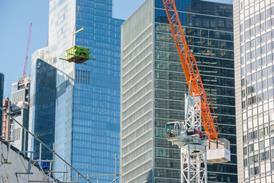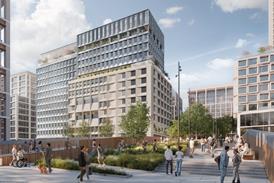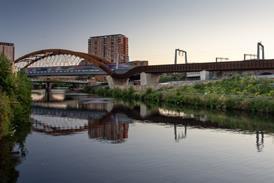Mackintosh’s devastated art school is not the only significant building in Glasgow that should be rebuilt, argues Ben Flatman

The latest disaster to befall Glasgow School of Art has already brought forth predictable calls for the site to be cleared and replaced by an entirely new design. But sometimes a building is simply too significant to let go, no matter how much it’s been damaged. The Mack is one of them, but British cities could benefit from taking a closer look at how Germany has quietly embarked on a more widespread reconstruction of its fire-ruined historic centres.
The hostility to creating replicas of destroyed buildings and cityscapes has its origins in modernist dogmas around “honesty” and “integrity” in materials and structure. The 1964 Venice Charter on restoration prohibited reconstruction based on “conjecture” and became a widely recognised global standard for how to manage the conservation and restoration of buildings. Once gone, it was deemed practically immoral to recreate what had been lost.
But the assumptions of those who drafted the charter are outdated and perhaps even culturally chauvinist. Try telling the Japanese that their regularly dismantled and rebuilt temples and shrines are inauthentic. Rebuilding replicas of what was there before is an integral part of Japanese traditional architectural culture and speaks to a deep-seated human desire for continuity and rootedness which old (or apparently old) buildings help provide.
Architects who self-identify as part of the modernist tradition tend to be the ones that have the most fraught relationship with the concept of total reconstruction. Although our profession has a wealth of expertise and knowledge in the field, those outside the conservation sector are often reluctant to countenance full-blown rebuilding. Many architecture schools still drill into their students a belief that such an approach is “pastiche” – a lazy and much abused term that modernists use to disparage everything from Quinlan Terry to the post-1989 reconstruction of Berlin.
And yet the world is full of widely recognised historic landmarks that have been rebuilt after being totally obliterated. When St Mark’s Campanile collapsed completely on July 14, 1902 Venetians found the money for its reconstruction the same day. Who now cares that it’s a facsimile of the original? And so Muriel Gray and all Glaswegians should trust their own instincts and rebuild the Mack.
But, frankly, why stop there? The city should not guiltily apologise for wanting to rebuild – something that most people instinctively feel is the right thing to do. Glasgow, once one of Britain’s great imperial cities, bears the scars of WWII bombing. But far more damaging has been the imprint of its post-war planning and economic decline. So after reconstructing Mackintosh’s masterpiece, why not set about a complete rebuild of “Greek” Thomson’s ruined Caledonia Road Church? And after that the city might want to consider rerouting the M8 and reclaiming its historic centre from the 20th-century road engineers.
The shadow of WWII hovers over all debates about reconstruction of fire-damaged buildings in the UK. We don’t like to admit it, but post-war reconstruction needlessly wrecked many British urban centres. It was not generally the Luftwaffe that did the real damage, as we comfortingly used to tell ourselves, but too often dogmatic and narrow-minded architects and planners, hell bent on using the slightest sign of bomb or fire damage as the excuse to widen roads and clear away what they regarded as the annoying clutter of old buildings.
Contrast Britain’s often forlorn and struggling provincial cities with those of Germany, where the Allies’ incendiary bombs inflicted far greater damage than the Luftwaffe ever did. Coventry, once one of our finest mediaeval cities, was almost comprehensively flattened and strangled by a ring road after the war, despite much being salvageable.
When German cities were rebuilt from near total destruction after WWII they took a variety of different approaches. But arguably the most successful have been those which rebuilt on historic street-plans, often salvaging or just plain rebuilding as much lost or damaged architecture as they could. In Cologne they rebuilt their Romanesque churches, and the locals resisted attempts to impose a new car-friendly road system, preferring their mediaeval streets. And more recently Dresden, now one of Germany’s boom towns, has opted for extensive rebuilding to recapture a sense of its lost baroque heart.
Perhaps the most striking recent example of this approach has been the “critical reconstruction” of Berlin. Dismissed by “avant-garde” modernists as irrelevant traditionalism, the planner Hans Stimmann’s vision for the city has nevertheless helped restore a strong sense of urban coherence to Berlin. Even Renzo Piano played along, describing his Potsdamer Platz project as “not a new city—this is the old”. By mixing restoration with contemporary new build and outright reconstruction in a very controlled way, Berlin has arguably repaired itself in a way that many thought was impossible to achieve. The huge numbers flocking to live and work there pay testament to Stimmann’s success.
So, yes, the Mack should be rebuilt, but it should also provoke a much wider and more profound debate about how we’ve uglified and pointlessly ravaged so many British streetscapes and how we might undo some of the damage.
Germany has adopted a pragmatic and varied approach to rebuilding its war- and fire-damaged cities. Like the Germans, we should rip off the tired modernist blinkers that still too often constrain discussions around our cities in the UK. The option to repair and even recreate what was lost should be a standard part of the urban repair toolbox.
















7 Readers' comments